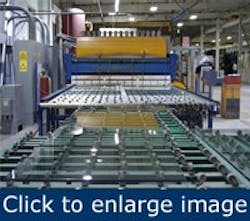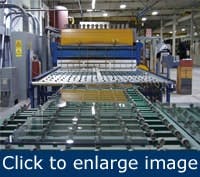OEM air system indicted in Massachusetts
In the fall of 2004, custom architectural glass manufacturer Solar Seal (www.solarseal.com), South Easton, Mass., updated its process for heat treating glass with one of the most modern convection ovens in the industry. The new oven package came with a third-party air system that included a 200-hp compressor and two 120-gal. receiver tanks.
The company’s existing Kaeser Compressors plant air system included a 50-hp SFC 37 variable-frequency-drive air compressor, a TD 61 Secotec refrigerated air dryer, an OR 250 oil removal filter and two 240-gal. tanks. This system supported applications throughout the plant over a range of demand from 57 cfm to 195 cfm at 108 psig to 110 psig.
“We didn’t have any choice in the compressor brand for the oven package,” says Eric Shaw, vice president, Solar Seal. “Our Kaeser equipment had always proven dependable and their representatives reliable. If we had the option, we would have selected an air system with a name we trusted.”
Shortly after the purchase of the glass oven package, Shaw and Bill Geary, Boston sales representative for Kaeser (http://us.kaeser.com), discussed both the new oven and the existing plant air systems. They concluded that because of Solar Seal’s growth, both air systems should undergo a Kaeser Air Demand Analysis (ADA).
Solar Seal appreciates its new glass-tempering oven, but found significant energy-saving opportunities in the compressed air system that came with it.
Kaeser Service Technician Brian Fahey installed monitoring sensors at strategic locations throughout the two air systems. During an eight-day period and without interruption to plant activities, the sensors collected data on load/unload signals, pressure signals, demand flow and required operational power.
The ADA survey revealed that none of the third-party equipment was appropriate for the oven system or Solar Seals requirements. The system’s standalone compressor was grossly oversized for the application, while the two 120-gal. tanks provided insufficient storage.
The oven package’s 200-hp machine provided 905 cfm, but the ADA determined the system’s demand ranged from 150 cfm to 635 cfm. The compressor was constantly cycling on and off — a big problem with a unit that size — because the tanks provided only minimal storage capacity. The rapid cycling caused excessive wear on the compressor, and it required a large, avoidable amount of electricity to produce an adequate flow.
“The oven’s air system was using a significant amount of energy unnecessarily,” says Geary. “We knew we could design a system to better meet the customer’s constantly fluctuating demand, while saving them a significant amount in energy costs.”
[pullquote]Kaeser engineers recommended eliminating the 200-hp compressor and combining the two air systems into one central system with a Sigma Air Manager (SAM) master controller. The SAM can control four compressors from a single control signal and turn on compressors only when they’re needed, so it often enables system operation at lower pressures and significantly reduces energy waste associated with leaks and artificial demand. The SAM also recognizes demand trends and balances compressor load hours for more effective maintenance scheduling.
Kaeser incorporated the existing dryer, filter and tanks into the new system, and uses the SFC 37 as a trim compressor. The central system has a SAM 4/4, a TG 301 Dual Control Demand dryer, KFC 1000-3M flow controller, an additional 2,200-gal. air receiver and an Aquamat 6 for responsible condensate removal.
The third-party air system equipment was replaced with a 40-hp ASD 40S compressor and two 60-hp BSD compressors (one BSD 60 is used strictly for backup). The two 120-gal.tanks were removed from the system and one of the 240-gal. tanks was inserted as a “wet” tank before the TG 301 dryer. The TD 61 Secotec dryer was taken in on trade, as the TG 301 dryer would handle the new system. Solar Seal had an additional 1,060-gal. tank as part of an older backup system, which was incorporated into the new system to further increase storage capacity. This proposed modular solution of using base load and trim compressors had a projected annual energy savings of $19,687, with a payback of 3.5 years.
Another significant financial incentive was a sizeable rebate from National Grid. The high-efficiency equipment qualified Solar Seal for $32,639. The SAM’s ability to optimize systems by avoiding unnecessary loading of additional machines and operating within a narrow pressure band contributed to the hefty monetary incentive.
“Running a business isn’t easy, and worrying about our compressed air system efficiency isn’t something I cared to continue doing,” says Shaw. “The Kaeser system was well worth the initial investment. We can monitor our system with SAM and see our system data anytime.”

